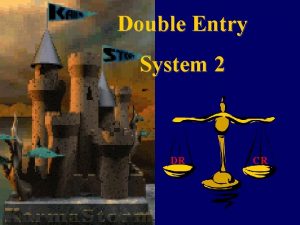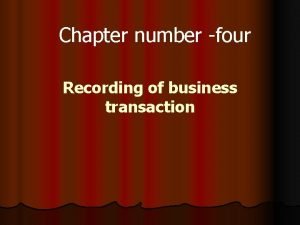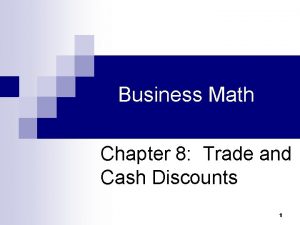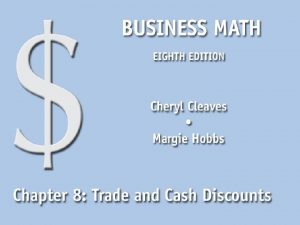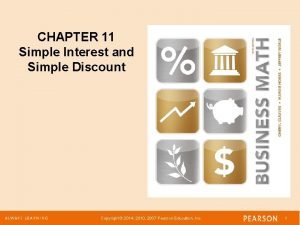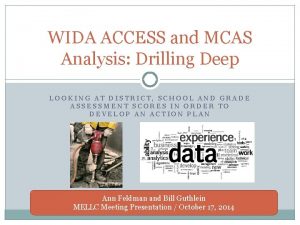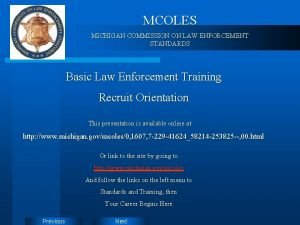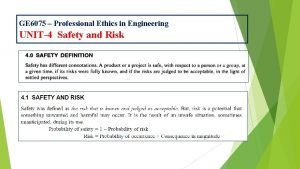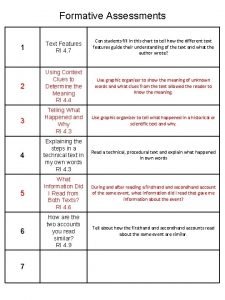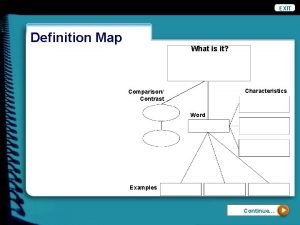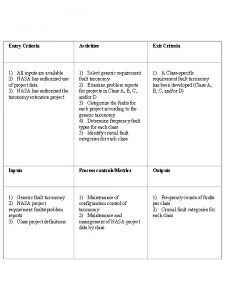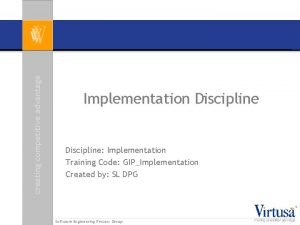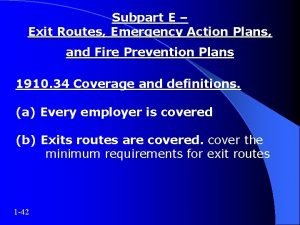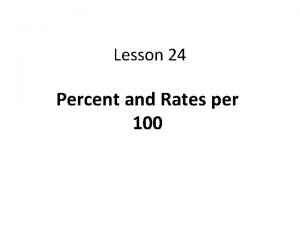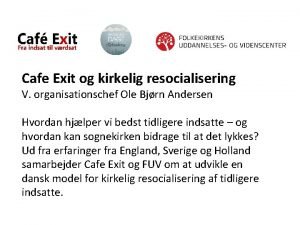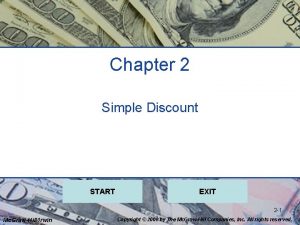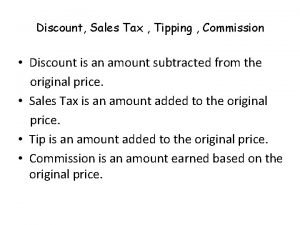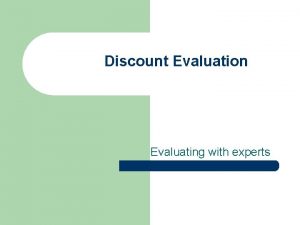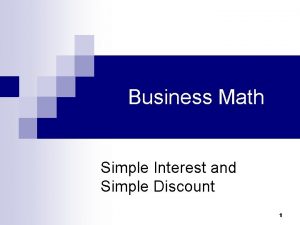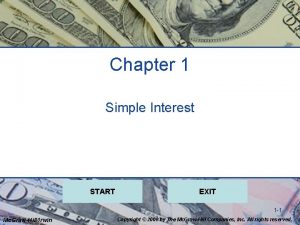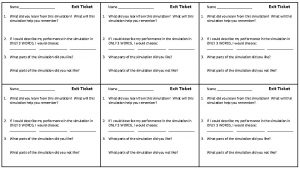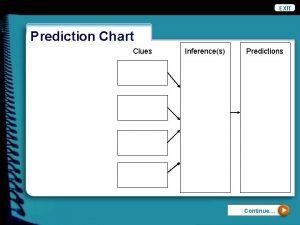Chapter 2 Simple Discount START EXIT 2 1





















































- Slides: 53

Chapter 2 Simple Discount START EXIT 2 -1 Mc. Graw-Hill/Irwin Copyright © 2008 by The Mc. Graw-Hill Companies, Inc. All rights reserved.

Chapter Outline 2. 1 Simple Discount 2. 2 Simple Discount vs. Simple Interest Chapter Summary Chapter Exercises 2 -2

2. 1 Simple Discount Definition 2. 1. 1 A loan that is made on the basis of a fixed maturity value is called a discount loan. The tender subtracts an amount, called the discount, from the maturity value, and pays the result, called the proceeds, to the borrower. 2 -3

2. 1 Simple Discount • Example 1 Jennifer knows she will be getting a paycheck for $500 at the end of the week, but she needs money now. She takes out a loan against this paycheck, borrowing as much as she can pay off with her check when it arrives. 2 -4

2. 1 Simple Discount • Example 2 When you file your federal income taxes, you find that you are owed a refund of $737. 15. Your tax preparer offers the option of getting your money right away, instead of waiting for the IRS to process your return and send your refund check. In exchange for agreeing to sign over your refund check when it arrives, the preparer agrees to lend you $707. 15 today. 2 -5

2. 1 Simple Discount • Example 3 The Eastern Junction Central School District is scheduled to receive a state aid check for $72, 500 on April 1. The district needs the funds by mid-February to meet expenses, but unfortunately the state is unwilling to make the payment early. In order to avoid a cash crunch, the district borrows $71, 342 from First Federal National Bank, to be repaid on April 1 when the state aid arrives. The amount borrowed is based on the $72, 500 that the district will have available for repayment when the aid check arrives. 2 -6

2. 1 Simple Discount A quick review… • If we look at the last example, we would call – – $71, 342 the principal $72, 500 -- $71, 342 = $1, 158 the interest $72, 500 (principal + interest) the maturity value April 1 the maturity date • However, when a promissory note is based on discount, the face value is not the same as its principal (as seen before). Definition 2. 1. 2 The face value of a discount note is its maturity value. 2 -7

2. 1 Simple Discount • One common example of a discount note is U. S. Savings Bonds. A savings bond is actually a promissory note issued by the U. S. government so, when you buy a savings bond, you are actually loaning money to Uncle Sam. • Although there are several types of savings bonds, the most familiar type is sold for half of its face value. • Therefore, a “$50 U. S. Savings Bond” actually costs only $25. The $50 face value reflects the amount the government guarantees that it will pay for the bond on maturity, which is usually many years away (usually 20 years). 2 -8

2. 1 Simple Discount • Treasury bills (known as T bills) are another common example of a discount note. They are short-term loans to the U. S. federal government, carrying terms ranging from a few days to 6 months, though the most common terms are 4, 13, or 26 weeks. • You might buy a $1, 000 face value T bill for $985, a $15 discount from the maturity value. 2 -9

2. 1 Simple Discount • Formula 2. 1 The Simple Discount Formula D = Md. T where – D represents the amount of SIMPLE DISCOUNT for a loan (equivalent to interest) – M represents the MATURITY VALUE – d represents the INTEREST DISCOUNT RATE – T represents the TERM FOR THE LOAN 2 -10

2. 1 Simple Discount Example 2. 1. 1 • Problem – A $10, 000 face value discount note has a term of 4 months. The simple discount rate is 6%. Find the amount of the discount. • Solution D = Md. T D = $10, 000 x 6% x 4/12 D = $10, 000 x 0. 06 x 4/12 D = $200 2 -11

2. 1 Simple Discount Example 2. 1. 2 • Problem – A $5, 000 face value note has a term of 219 days. The simple discount rate is 9 3/8%. Find the proceeds of the note. • Solution D = Md. T D = $5, 000 x 9 3/8% x 219/365 D = $281. 25 Proceeds = Maturity Value – Discount Proceeds = $5, 000 -- $281. 25 = $4, 718. 75 2 -12

2. 1 Simple Discount Example 2. 1. 3 • Problem – A 3 -month note is discounted by $28. 75. The simple discount rate is 5 ¾%. Determine the maturity value and the proceeds of the note. • Solution D = Md. T $28. 75 = M(5 ¾%)(3/12) $28. 75 = M(5. 75%)(3/12) $28. 75 = M(0. 0575)(3/12) $28. 75 = M(0. 014375) M = $2, 000 Proceeds = Maturity Value – Discount Proceeds = $2, 000 -- $28. 75 = $1, 971. 25 2 -13

2. 1 Simple Discount Example 2. 1. 4 • Problem – When Jim filed his federal income taxes, he was happy to learn that he was due a refund of $799. 45. He was less happy to learn that it would take 45 days for his refund check to arrive. His tax preparer offered to give him $775. 00 on the spot, in exchange for Jim’s tax refund check when it arrives. What simple discount rate does this offer equate to? • Solution Discount = $799. 45 -- $775. 00 = $24. 45 D = Md. T $24. 45 = $799. 45 x d x 45/365 $24. 45 = $98. 56232877 x d d = 0. 248066379 d = 24. 81% 2 -14

2. 1 Simple Discount Example 2. 1. 5 • Problem – A $10, 000 T bill with 182 days to maturity sold at auction for $9, 753. 16. What is the simple discount rate? • Solution Discount = $10, 000 -- $9, 753. 16 = $246. 84 D = Md. T $246. 84 = $10, 000 x d x 182/365 $246. 84 = $4, 986. 3013699 x d d = 0. 04950363 d = 4. 95% 2 -15

2. 1 Simple Discount Example 2. 1. 6 • Problem – XYZ Financial Corp invested $49, 200 in discount bonds with face values totaling $50, 000. The discount rate was 4%. How long will it be until the notes mature? • Solution Discount = $50, 000 -- $49, 200 = $800 D = Md. T $800 = $50, 000 x 4% x T $800 = $50, 000 x 0. 04 x T $800 = $2, 000 x T T = 0. 4 years T = 0. 4 x 365 = 146 days 2 -16

2. 1 Simple Discount Example 2. 1. 7 • Problem – The Florida Central School District borrowed $4, 959, 247 on March 7, 2005, in anticipation of receiving a state aid payment of $5, 000. The loan was based on a simple discount rate of 4 ¼%. On what date will the district receive its state aid? • Solution Discount = $5, 000 -- $4, 959, 247 = $40, 753 D = Md. T $40, 753 = $5, 000 x 4 ¼% x T $40, 753 = $5, 000 x 0. 0425 x T T = 0. 1917788235 years T = 0. 1917788235 x 365 = 70 days March 7 is the 65 th day of the year so the note matures on the 66 + 70 = 136 th day of the year. The state aid will be received on May 16, 2005. 2 -17

Section 2. 1 Exercises Problem 1: Simple Discount and Proceeds Problem 2: Maturity Value Problem 3: Discount Rate Problem 4: Term 2 -18

Problem 1 • New York Chamber of Commerce issued discount notes to finance a downtown renovation and beautification project. Each discount note has a face value of $2, 000 and a term of 10 years. The notes were sold at a simple discount rate of 4 ½%. • Find the proceeds of each note sold. CHECK YOUR ANSWER 2 -19

Solution 1 • New York Chamber of Commerce issued discount notes to finance a downtown renovation and beautification project. Each discount note has a face value of $2, 000 and a term of 10 years. The notes were sold at a simple discount rate of 4 ½%. Find the proceeds of each note sold. • D = Md. T • D = $2, 000 x 4 ½% x 10 • D = $2, 000 x 4. 5% x 10 • D = $2, 000 x 0. 045 x 10 • D = $900 • Proceeds = Face Value – Discount • Proceeds = $2, 000 -- $900 = $1, 100 BACK TO GAME BOARD 2 -20

Problem 2 • Find the maturity value of a 9 -month discount note if the discount is $70 and the discount rate is 11. 9%. CHECK YOUR ANSWER 2 -21

Solution 2 • Find the maturity value of a 9 -month discount note if the discount is $70 and the discount rate is 11. 9%. • D = Md. T • $70 = M x 11. 9% x 9/12 • $70 = M x 0. 119 x 9/12 • $70 = M x 0. 08925 • M = $784. 31 BACK TO GAME BOARD 2 -22

Problem 3 • Lynn’s Hair Salon signed a $10, 000 discount note with a term of 120 days and received proceeds of $9, 500. What is a simple discount rate for this note? CHECK YOUR ANSWER 2 -23

Solution 3 • Lynn’s Hair Salon signed a $10, 000 discount note with a term of 120 days and received proceeds of $9, 500. What is a simple discount rate for this note? • D = Md. T • $500 = $10, 000 x d x 120/365 • $500 = $3, 287. 67 x d • d = 0. 15208 • d = 15. 21% BACK TO GAME BOARD 2 -24

Problem 4 • On May 11, 2007, you bought a $2, 000 T bill for $1, 950. The simple discount rate was 5%. What is the term? CHECK YOUR ANSWER 2 -25

Solution 4 • On May 11, 2007, you bought a $2, 000 T bill for $1, 950. The simple discount rate was 5%. What is the term? • D = Md. T • $50 = $2, 000 x 5% x T • $50 = $2, 000 x 0. 05 x T • $50 = $100 x T • T = 0. 5 years • T = 0. 5 x 365 = 183 days BACK TO GAME BOARD 2 -26

2. 2 Simple Discount vs. Simple Interest • Suppose that Big Office Supply borrowed $38, 000 for 1 year from Van Buren Capital Funding Corp. The maturity value of the note was $40, 000. Was this loan based on simple discount or simple interest? • Simple interest? Principal = $38, 000 Interest = $2, 000 Maturity Value = $38, 000 + $2, 000 = $40, 000 • Simple discount? Maturity Value = $40, 000 Discount = $2, 000 Proceeds = $38, 000 • Actually, interest and discount are just two different ways of looking at the same thing. • However, we can take a look at the deal both ways and compare simple interest and simple discount rates. 2 -27

2. 2 Simple Discount vs. Simple Interest Example 2. 2. 1 • Problem – For the transaction described on the previous slide, find (a) the simple interest rate and (b) the simple discount rate. • Solution (a) I = PRT $2, 000 = $38, 000 x R x 1 R = 0. 0526 = 5. 26% Therefore, the simple interest rate is 5. 26%. (b) D = Md. T $2, 000 = $40, 000 x d x 1 d = 0. 05 = 5% Therefore, the simple discount rate is 5%. 2 -28

2. 2 Simple Discount vs. Simple Interest • The results on a previous slide may be surprising. However, the simple interest and simple discount rates are not the same thing. • A rate is a percent, and a percent must be of something. • For simple interest, that something is the principal ($2, 000 as a percent of $38, 000). • For simple discount, that something is the maturity value ($2, 000 as a percent of $40, 000). • Since the principal and maturity value are always different, for a given loan the simple interest rate and simple discount rate will never be same. • Because the principal will always be less than the maturity value for any loan, the simple interest rate will always be larger than the simple discount rate. 2 -29

2. 2 Simple Discount vs. Simple Interest Example 2. 2. 2 • Problem – XYZ Financial invested $49, 200 in bonds whose maturity values totaled $50, 000. The remaining term of the bonds was 146 days. The simple discount rate was 4%, but what would the equivalent simple interest rate be? • Solution I = PRT $800 = $49, 200 x R x 146/365 R = 4. 07% 2 -30

2. 2 Simple Discount vs. Simple Interest Example 2. 2. 3 • Problem – An investment manager is weighing a choice between two possible investments for a fund that she manages. She originally had planned to invest in a $10, 000 face value, 9 -month simple discount note issued by the TY Company, which she was offered at a simple discount rate of 8%. On the other hand, the company has offered to borrow the same amount of money from her fund by signing a note carrying a simple interest rate of 8 ¼%. Which is the better deal for the investment fund? • Solution – On the face of it, this looks like a pretty simple question; 8 ¼% is higher than 8%, and so obviously a lender would prefer the higher rate. – Discount D = Md. T, D = $10, 000 x 8% x 9/12 = $600 Therefore, the fund would pay $10, 000 - $600 = $9, 400 for the note – Simple Interest I = PRT, $600 = $9, 400 x R x 9/12, R = 8. 51% – The 8% simple discount rate is actually equivalent to earning an 8. 51% simple interest rate. 2 -31

2. 2 Simple Discount vs. Simple Interest • When rates quoted for investments are based on discount, often both the interest and discount rate will be given. • Note that the rates differ, depending on the maturity date for the note. U. S. Treasury Bill Current Market Rates Maturity Date Discount Rate Interest Rate 8/31/06 4. 95% 4. 97% 11/30/06 5. 13% 5. 20% 2 -32

2. 2 Simple Discount vs. Simple Interest • A payday lender is an individual or business that will offer to give you immediate cash in exchange for your agreement to sign over your check to the lender when you receive it. • Suppose that such a lender offers to make this deal with you for a fee of 2% of the paycheck. • It would be quite easy to think of that 2% as a rate per year. • However, the fee is “ 2% of the paycheck. ” So the lender will take a discount of 2% x $750 = $15. 00, leaving you with $735. • What is the equivalent simple discount rate if the term of the loan is 4 days? D = Md. T, $15 = $750 x d x 4/365, d = 1. 825 = 182. 50% • A 2% fee doesn’t sound like all that much to pay, but putting it in terms of an annual simple discount rate puts a new perspective on it. • What is the equivalent simple interest rate? I = PRT, $15 = $735 x R x 4/365, R = 1. 8622 = 186. 22% 2 -33

2. 2 Simple Discount vs. Simple Interest Example 2. 2. 4 • Problem – Amanda is expecting a $795 paycheck in 8 days. A payday lender offers to give her cash now for this check. The lender’s fee is 1. 5% of the amount, plus a $10 service fee. Find the equivalent simple interest and simple discount rates. • Solution – First, we need to determine how much Amanda will be giving up: 1. 5% of her paycheck is $11. 93. Adding in the $10 service fee, the total is $21. 93. She will receive the difference, $773. 07. – Simple Discount D = Md. T $21. 93 = $795 x d x 8/365 d = 1. 2586 = 125. 86% – Simple Interest I = PRT $21. 93 = $773. 07 x R x 8/365 R = 1. 2943 = 129. 43% 2 -34

Section 2. 2 Exercises Problem 1: Interest Rate vs. Discount Rate Problem 2: Equivalent Interest Rate Problem 3: Rates in Disguise Problem 4: Grab Bag 2 -35

Problem 1 • Ellen loans her brother $150 and he pays her back $160 ninety days later. • Find (a) the simple interest rate and (b) the simple discount rate. CHECK YOUR ANSWER 2 -36

Solution 1 • Elaine loans her brother $150 and he pays her back $160 ninety days later. Find (a) the simple interest rate and (b) the simple discount rate. • Simple Interest Rate I = PRT $10 = $150 x R x 90/365 $10 = 36. 98630 x R R = 0. 27037 = 27% • Simple Discount Rate D = Md. T $10 = $160 x d x 90/365 $10 = 39. 45205 x d d = 0. 25347 = 25% BACK TO GAME BOARD 2 -37

Problem 2 • A $2, 000 maturity value with a 180 -day term is sold at a simple discount rate of 7. 99%. Find the simple interest rate that would be equivalent to the stated simple discount rate. CHECK YOUR ANSWER 2 -38

Solution 2 • A $2, 000 maturity value with a 180 -day term is sold at a simple discount rate of 7. 99%. Find the simple interest rate that would be equivalent to the stated simple discount rate. • D = Md. T D = $2, 000 x 7. 99% x 180/365 D = $2, 000 x 0. 0799 x 180/365 D = $78. 81 • I = PRT $78. 81 = $1, 921. 19 x R x 180/365 $78. 81 = $947. 44 x R R = 0. 08318 = 8. 32% BACK TO GAME BOARD 2 -39

Problem 3 • Christy will receive a $1, 500 paycheck in 14 days. However, she needs money now. A payday lender offers to give her cash today for a fee of 2% of the check amount. • Find (a) the equivalent simple discount rate and (b) the equivalent simple interest rate. CHECK YOUR ANSWER 2 -40

Solution 3 • Christy will receive a $1, 500 paycheck in 14 days. However, she needs money now. A payday lender offers to give her cash today for a fee of 2% of the check amount. Find (a) the equivalent simple discount rate and (b) the equivalent simple interest rate. • Christy will be giving up $1, 500 x 2% = $30, so she will receive $1, 470. • D = Md. T $30 = $1, 500 x d x 14/365 $30 = $57. 53 x d d = 0. 52146 = 52. 15% • I = PRT $30 = $1, 470 x R x 14/365 $30 = $56. 38 x R R = 0. 53210 = 53. 21% BACK TO GAME BOARD 2 -41

Problem 4 • An annual subscription to your favorite magazine costs $45. 99. Although subscription renewal isn’t due for another three months, the publisher is offering you a 5% off the regular price if you renew now. What would be the simple interest rate? CHECK YOUR ANSWER 2 -42

Solution 4 • An annual subscription to your favorite magazine costs $45. 99. Although subscription renewal isn’t due for another three months, the publisher is offering you a 5% discount off the regular price if you renew now. What would be the simple interest rate? • Since you will save $45. 99 x 5% = $2. 30 and actually pay $45. 99 -- $2. 30 = $43. 69 • I = PRT $2. 30 = $43. 69 x R x 3/12 $2. 30 = 10. 9225 x R R = 0. 21057 = 21. 06% BACK TO GAME BOARD 2 -43

Chapter 2 Summary • The Concept of Discount • Calculating Simple Discount and Proceeds • Finding Maturity Value, Simple Discount Rate, and Term • Simple Interest vs. Simple Discount 2 -44

Chapter 2 Exercises Section 2. 1 Section 2. 2 Section 2. 3 $100 $200 EXIT 2 -45

Section 2. 1 -- $100 • A note with a maturity value of $5, 600 is due in 60 days, and is discounted at a rate of 7. 5%. Find the amount of the discount and the proceeds of the loan. CHECK YOUR ANSWER 2 -46

Section 2. 1 -- $100 • A note with a maturity value of $5, 600 is due in 60 days, and is discounted at a rate of 7. 5%. Find the amount of the discount and the proceeds of the loan. • D = Md. T D = $5, 600 x 7. 5% x 60/365 D = $69. 04 Proceeds = $5, 600 -- $69. 04 = $5, 530. 96 BACK TO GAME BOARD 2 -47

Section 2. 1 -- $200 • A 9 -month note is discounted by $73. 28. The simple discount rate is 5 ½%. Determine the maturity value of the note. CHECK YOUR ANSWER 2 -48

Section 2. 1 -- $200 • A 9 -month note is discounted by $73. 28. The simple discount rate is 5 ½%. Determine the maturity value of the note. • D = Md. T $73. 28 = M x 5 ½% x 9/12 $73. 28 = M x 0. 04125 M = $1, 776. 48 BACK TO GAME BOARD 2 -49

Section 2. 2 -- $100 • First Port City Bank lends $50, 000 to the local business in exchange for a $53, 000 payment 6 months later. • Find (a) the simple interest rate and (b) the simple discount rate. CHECK YOUR ANSWER 2 -50

Section 2. 2 -- $100 • First Port City Bank lends $50, 000 to the local business in exchange for a $53, 000 payment 6 months later. • Find (a) the simple interest rate and (b) the simple discount rate. • I = PRT $3, 000 = $50, 000 x R x 6/12 $3, 000 = $25, 000 x R R = 0. 12 = 12% • D = Md. T $3, 000 = $53, 000 x d x 6/12 $3, 000 = $26, 500 x d d = 0. 113207 = 11. 32% BACK TO GAME BOARD 2 -51

Section 2. 2 -- $200 • Reynolds Financial Inc. invested $57, 100 in bonds whose maturity values totaled $58, 000. The remaining term of the bonds was 140 days. The simple discount rate was 4. 5%. What would be the equivalent simple interest rate? CHECK YOUR ANSWER 2 -52

Section 2. 2 -- $200 • Reynolds Financial Inc. invested $57, 100 in bonds whose maturity values totaled $58, 000. The remaining term of the bonds was 140 days. The simple discount rate was 4. 5%. What would be the equivalent simple interest rate? • I = PRT $900 = $57, 100 x R x 140/365 $900 = 21901. 36986 x R R = 0. 04109 = 4. 11% BACK TO GAME BOARD 2 -53
 Egress corridor definition
Egress corridor definition Exit exit access and exit discharge
Exit exit access and exit discharge Discount entries
Discount entries Trade discount vs sales discount
Trade discount vs sales discount Discount rate formula in business math
Discount rate formula in business math Single trade discounts
Single trade discounts Simple interest and discount
Simple interest and discount Simple discount
Simple discount Site:slidetodoc.com
Site:slidetodoc.com Triage jump start
Triage jump start Simple discount notes
Simple discount notes Does nick like gatsby chapter 8
Does nick like gatsby chapter 8 Simple present simple past simple future
Simple present simple past simple future Simple past simple present simple future
Simple past simple present simple future Present simple present continuous past simple future simple
Present simple present continuous past simple future simple Past simple present simple future simple
Past simple present simple future simple Present simple, past simple, future simple
Present simple, past simple, future simple Present past future simple present continuous exercises
Present past future simple present continuous exercises Swing past participle
Swing past participle Simple present afirmativa, negativa e interrogativa
Simple present afirmativa, negativa e interrogativa Future simple present simple
Future simple present simple Karakia for a meeting
Karakia for a meeting 3 2 1 exit ticket
3 2 1 exit ticket Curriculum guide for driver education in virginia module 5
Curriculum guide for driver education in virginia module 5 Project exit criteria
Project exit criteria Cps algebra exit exam
Cps algebra exit exam Sap conversion exit
Sap conversion exit How to ace an exit interview
How to ace an exit interview Mcoles exit standards
Mcoles exit standards Sap s4 pce
Sap s4 pce Fault tree analysis in professional ethics
Fault tree analysis in professional ethics Text structure exit ticket
Text structure exit ticket Exit ticket app
Exit ticket app Exit definition
Exit definition Project exit criteria
Project exit criteria Eet writing test sample
Eet writing test sample Format email eet
Format email eet Wood badge ticket examples
Wood badge ticket examples Exit policy
Exit policy As per gip which of the following form entry criteria
As per gip which of the following form entry criteria Client exit interview
Client exit interview Balanced articulation
Balanced articulation Dasar pemisah ukm
Dasar pemisah ukm 1910 subpart e
1910 subpart e Uat exit criteria
Uat exit criteria Press esc to exit
Press esc to exit Marissa just bought 100 acres of land
Marissa just bought 100 acres of land Udinus
Udinus 22 bullet hole in glass
22 bullet hole in glass Wlan exit point
Wlan exit point Senior exit project ideas
Senior exit project ideas Sap user exit이란
Sap user exit이란 Excerpt meaning
Excerpt meaning Spread of islam through architecture exit slip
Spread of islam through architecture exit slip


